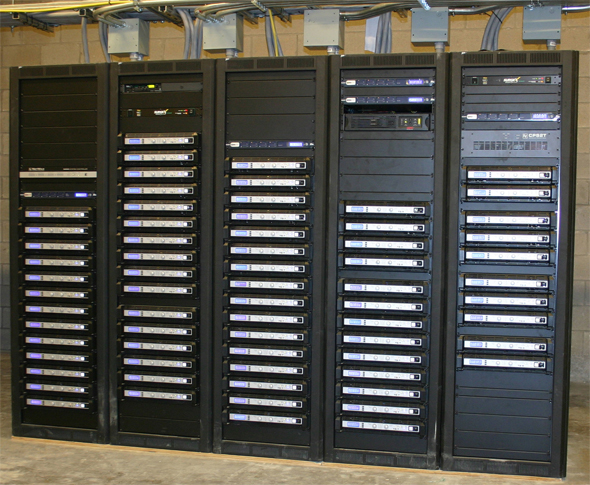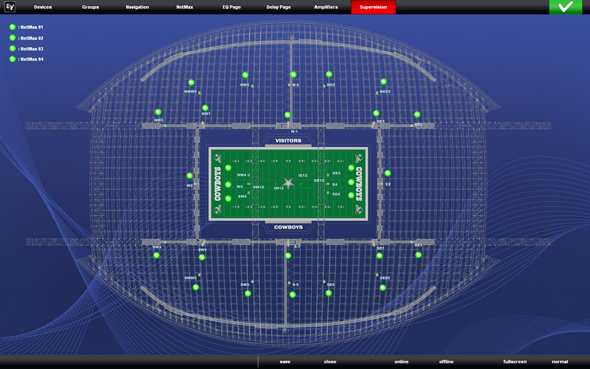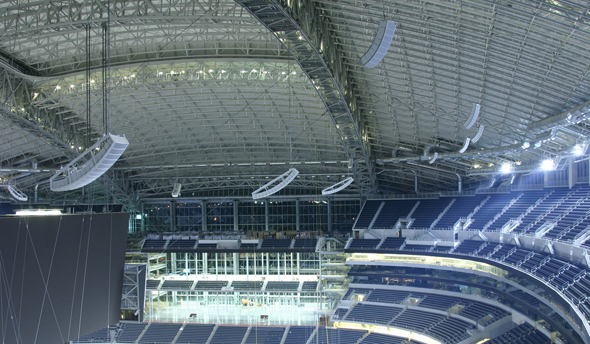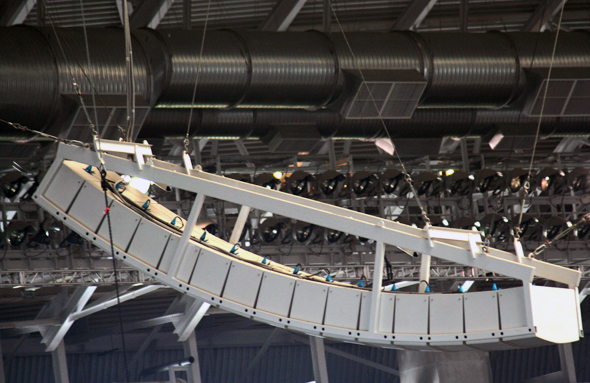
The M7CL’s main output feeds a 1RU Oxmoor RMX-44 mixing matrix to accept changeover from fire alarm alarms, then goes to an Aphex Dominator to provide absolute peak limiting, before being delivered to the BSS London BLU-800 that’s the mix position’s gateway to the system’s CobraNet fiber backbone.
“I use CobraNet for its ease of interoperability between various manufacturers’ equipment,” Day notes, adding, “In a venue of this size, digital latency isn’t a big factor, as it would be in other types of audio systems.”
At each of the four corners of the stadium, between the uppermost seating and the catwalks, are the “engine rooms” that power the overhead line arrays. BSS London BLU-320 interfaces deliver signals to an EV N8000 NetMax digital matrix controller, whose FIR filter technology combines crossover and EQ correction in a single filter to provide linear phase optimization for EV loudspeakers.
The main loudspeaker arrays are powered by 228 of EV’s new class H Tour Grade amplifiers, with RCM-26 DSP modules. TG5’s power all high frequency drivers and TG7s power the rest.
In addition to providing AES inputs as the final link in a digital signal chain, RCM-26 modules in the TG amps provide remote control and monitoring, including one-button system check over IRIS-Net, as well as additional FIR-filters and speaker protection.
“We needed to be able to critically supervise each piece of equipment to prevent expensive repairs or driver replacements from being necessary,” Day adds. “Load monitoring is a critical feature when your speakers are 200 feet off the ground at the end of a quarter-mile of cable.
Between the TG amps, IRIS-Net, and NetMax, the range of control and monitoring features this system has gives us the assurance that won’t be an issue.”
Those familiar with Los Angeles’ Staples center and its triple row of glass-fronted luxury suites recognize one problem faced at Cowboys Stadium on a larger scale. A 30- foot high glass wall for the suites separates the lower bowl of the stadium from the upper-most seating area – the 400 sections.
The main loudspeaker system is comprised of three sub-systems, each constructed from a different EV line array product. Immediately apparent are three large-format 15-box X-Line XLV arrays on each side of the field that cover the lower bowl with an angle that approaches horizontal. Additionally, two 7-box XLV arrays cover the lower bowl’s end zones.
Due to the compression placed on the enclosures at such a radical angle, plus the fact that it’s a permanent installation, ProMedia designed custom “sleds” to hold these arrays.
These were rigged by John Bleich’s ProRig of Dallas using SkyClimber wire-rope winches, typically used for skyscraper window washing.
The 400-level seats in the upper bowl are covered with seven mid-sized 8-box XLC arrays on each side of the field. Additional coverage of the field’s perimeter to the first couple rows of seats comes from six compact 5-box XLE arrays, three on each end of the overhead video screen.
In total, the line array spec includes 104 X-Line (Xvls & Xvlt) large-format line array elements, 108 XLCi127DVX medium-format line array elements, and 30 XLE181 compact line array elements.
The stadium’s sheer size required cable runs of 1,000 to 1,600 feet for the overhead clusters, using 12-gauge multi-conductor Belden wire for mids and highs, and 10-gauge for the lows. Since the stadium’s roof opens to expose the arrays to the elements, the X-Line cabinets were special-ordered with blue polyester Meltric PN12 multi-pin connectors rated for weather exposure.
Two days before the first Cowboys pre-season game, Paul McCartney performed for a sold-out crowd, and I ran across this anecdote: “During the “Na na na na” portion of main set-closer ‘Hey Jude’, McCartney asked various sections to sing the parts for him. They did, although when he called out on the top section to sing it for him, it seemed that they were refusing. McCartney, on stage, looked confused. Then, maybe two seconds later, the sound of their voices finally reached him on stage. That’s how big this stadium is, folks.” – Pete Freedman, Dallas Observer
Mark Frink is Associate Editor for Live Sound International.




